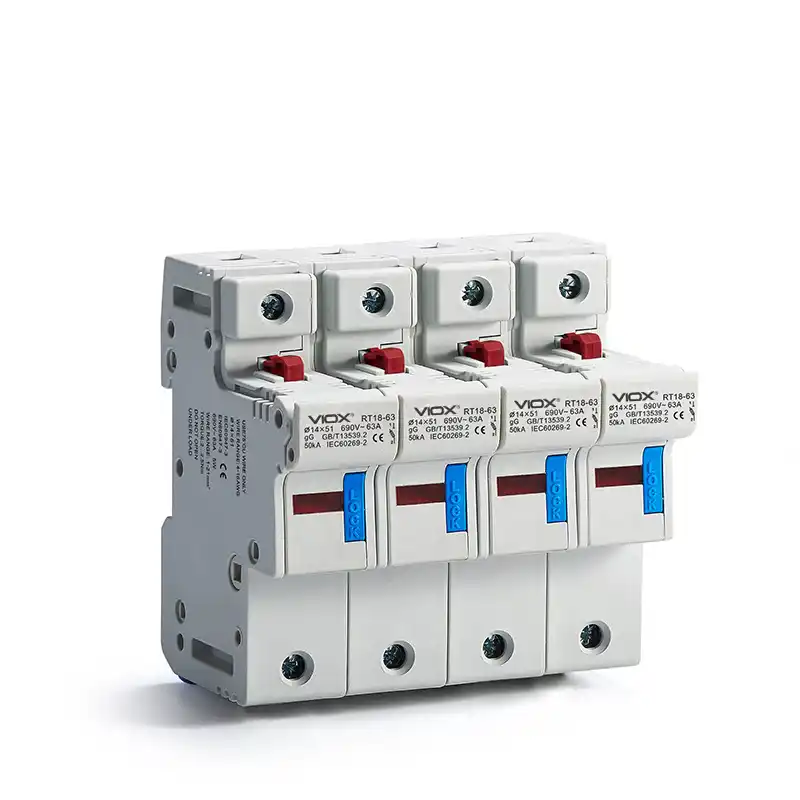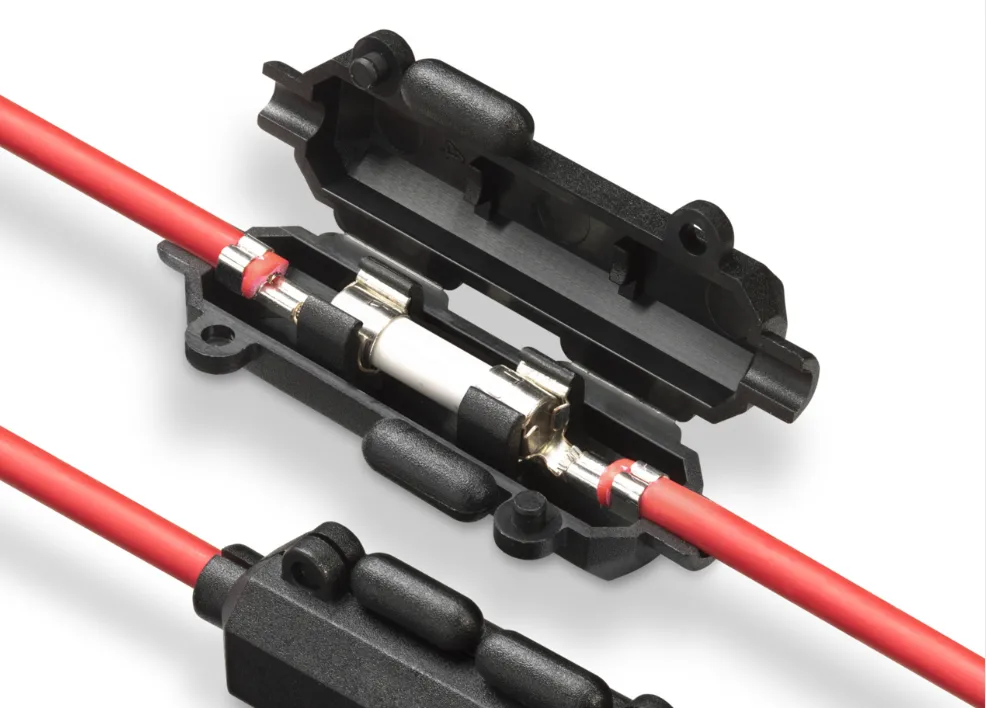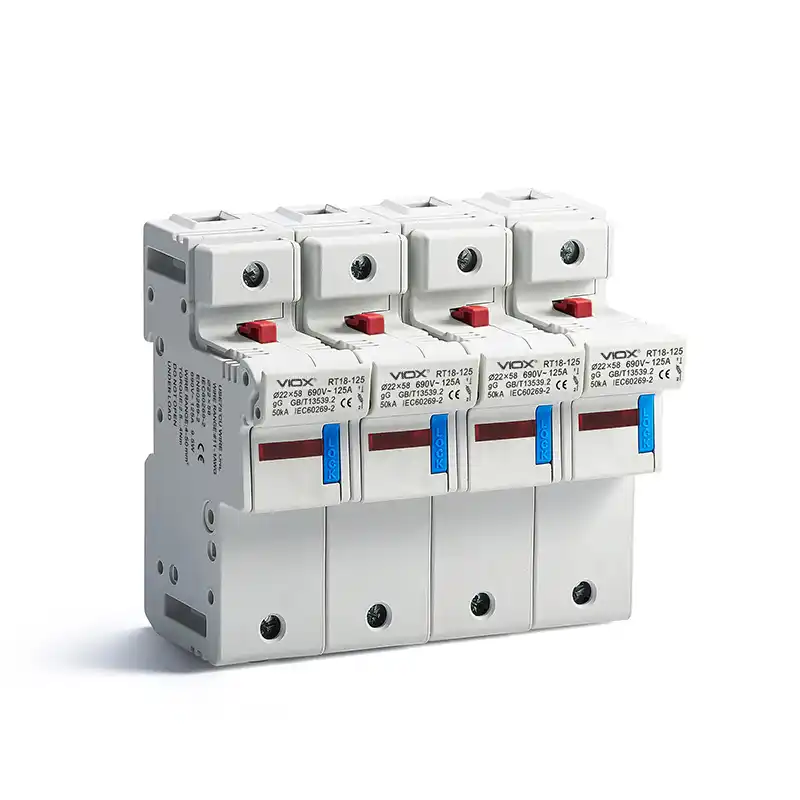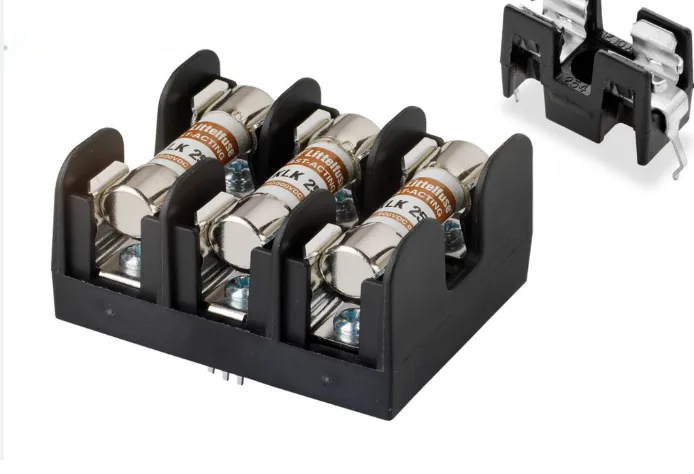Когда электрические системы выходят из строя катастрофически, ущерб может быть разрушительным — сгоревшее оборудование, опасность возгорания и дорогостоящий ремонт. В основе предотвращения этих катастроф лежит простой, но важный компонент: держатель предохранителя. Понимание как работает держатель предохранителя — это не просто технические знания; это важная информация по технике безопасности, которую должен освоить каждый электрик, автомеханик и любитель самостоятельного ремонта.
Держатель предохранителя — это гораздо больше, чем просто монтажное устройство. Это точно спроектированный компонент, который обеспечивает надежные электрические соединения, обеспечивает защиту окружающей среды и позволяет безопасно заменять предохранитель при возникновении перегрузки по току. Независимо от того, работаете ли вы с автомобильными электрическими системами, морскими установками или проектами по домашней электропроводке, знание того, как работают держатели предохранителей, поможет вам создавать более безопасные и надежные электрические системы.
Что такое держатель предохранителя и почему он так необходим?

A держатель предохранителя это защитное устройство, специально разработанное для надежного крепления и электрического соединения предохранителя в электрической цепи. В то время как предохранители обеспечивают фактическую защиту от сверхтоков, расплавляясь при достижении опасного уровня тока, держатель предохранителя служит критическим интерфейсом между предохранителем и электрической системой.
Основные функции держателя предохранителя включают в себя:
- Надежное крепление: Предотвращает ослабление или смещение предохранителей под воздействием вибрации, что может привести к нестабильным соединениям или полному отказу цепи.
- Надежное электрическое соединение: Обеспечивает постоянный ток через точно спроектированные контактные точки, которые минимизируют сопротивление и накопление тепла.
- Охрана окружающей среды: защищает предохранители от влаги, пыли, коррозии и других факторов окружающей среды, которые могут ухудшить их работу.
- Безопасная доступность: Позволяет легко проверять и заменять предохранители, не подвергая пользователей воздействию опасного напряжения и не требуя разборки цепи.
Без надлежащих держателей предохранителей даже самые качественные предохранители не могут обеспечить надежную защиту. Плохие соединения могут создавать точки нагрева, вызывать падение напряжения или препятствовать правильной работе предохранителей в условиях перегрузки по току.
Как работает держатель предохранителя? Полный механизм
Основной принцип работы
Понимание как работает держатель предохранителя требует проверки полного пути тока от входа цепи до выхода. Когда электрический ток протекает через правильно установленный держатель предохранителя, он следует этой точной последовательности:
- Текущая запись: Электрический ток поступает в держатель предохранителя через входную клемму, которая обычно подключена к источнику питания или входной цепи.
- Терминал Контакт: Ток течет от клеммы через тщательно спроектированные контактные поверхности, которые захватывают концевые крышки предохранителя.
- Путь предохранителя: Ток проходит через сам предохранительный элемент, где и реализуется защитная функция.
- Выйти из контакта: После прохождения через предохранитель ток течет через выходной контакт к выходной клемме.
- Завершение цепи: Ток продолжается к защищенной нагрузке или компонентам цепи ниже по течению.
Этот, казалось бы, простой процесс требует точной инженерии, чтобы обеспечить соединения с низким сопротивлением, надлежащий отвод тепла и надежное контактное давление в различных условиях окружающей среды.
Основные компоненты держателя предохранителя
Каждый держатель предохранителя содержит несколько важных компонентов, которые работают вместе, обеспечивая надежную работу:
- Терминалы: Они выполняют двойную функцию — принимают входящий ток из цепи и возвращают его обратно в цепь после прохождения через предохранитель. Клеммы обычно изготавливаются из медных сплавов с гальваническим покрытием, таким как олово или серебро, для предотвращения коррозии и обеспечения оптимальной проводимости.
- Контакты: Самый важный компонент, контакты физически взаимодействуют с концевыми заглушками предохранителя для создания электрического соединения. Они часто проектируются как пружинные зажимы, зажимы или гнезда, которые обеспечивают постоянное давление и принимают небольшие изменения в размерах предохранителя.
- Жилье: Внешняя оболочка обеспечивает механическую защиту, герметизацию от окружающей среды и электрическую изоляцию. Материалы варьируются от пластика для основных применений до металла или керамики для использования в условиях высоких температур или суровых условий.
- Система крепления: В зависимости от типа сюда входят штифты для монтажа на печатную плату, резьбовые соединения для монтажа на панель, точки крепления проводов или точки встроенного соединения.
Пошаговый процесс работы
Последовательность работы держателя предохранителя в нормальных и неисправных условиях демонстрирует его важную роль в обеспечении безопасности:
- Нормальная работа: Ток плавно течет через клеммы и контакты держателя к элементу предохранителя. Правильно спроектированные держатели поддерживают соединения с низким сопротивлением, которые генерируют минимальное тепло, обеспечивая эффективную передачу мощности и длительный срок службы компонента.
- Обнаружение перегрузки по току: При возникновении опасного уровня тока предохранительный элемент начинает нагреваться. Держатель должен поддерживать надежный контакт в течение этого критического периода, защищая окружающие компоненты от чрезмерного нагрева.
- Прерывание цепи: Поскольку плавкий элемент предохранителя плавится и создает дугу, конструкция держателя должна надежно сдерживать эту дугу до тех пор, пока она не погаснет, предотвращая повреждение самого держателя и окружающего оборудования.
- Безопасность после сбоя: После срабатывания предохранителя держатель должен четко указывать на состояние перегоревшего предохранителя и обеспечивать безопасную замену, не подвергая пользователей воздействию опасного напряжения.
Типы держателей предохранителей и принцип их работы
В электротехнической промышленности используется несколько различных конструкций держателей предохранителей, каждая из которых оптимизирована для конкретных областей применения и требований к установке.
Держатели встроенных предохранителей

Держатели предохранителей в линию представляют собой наиболее распространенный тип, используемый в автомобильной и морской промышленности. Эти держатели устанавливаются непосредственно в жгуты проводов, создавая защищенную точку соединения вдоль пути тока.
Рабочий механизм включает в себя две точки соединения проводов — вход и выход — с предохранителем, создающим мост между ними. При правильной установке линейные держатели обеспечивают превосходную защиту для ответвлений цепей, сохраняя при этом гибкость для прокладки защиты именно там, где это необходимо.
Ключевые преимущества включают в себя простую установку в существующую проводку, отличные варианты герметизации окружающей среды и возможность размещения защиты вблизи потенциальных источников неисправности. Многие линейные держатели имеют прозрачные или полупрозрачные корпуса, которые позволяют визуально проверять предохранители без разборки.
Держатели предохранителей на DIN-рейку

Держатели предохранителей на DIN-рейку специально разработаны для промышленных панелей управления с использованием стандартных систем монтажа на DIN-рейку. Эти держатели, включая популярные серии, такие как RT18, обеспечивают профессиональную защиту предохранителей в организованных, доступных панелях.
Рабочий механизм включает в себя подпружиненную систему крепления, которая надежно крепится на стандартные 35-миллиметровые DIN-рейки, обеспечивая при этом винтовые клеммные соединения для надежной полевой проводки. Серия РТ18 и подобные держатели обычно имеют:
- Модульная конструкция: Отдельные держатели могут быть установлены рядом для многоцепной защиты, доступны конфигурации от 1P до 4P (включая 3P+N для трехфазных систем)
- Простая установка: Крепление на DIN-рейку с защелкой не требует инструментов для базовой установки
- Светодиодные индикаторы: Встроенные визуальные индикаторы показывают состояние предохранителя, некоторые модели оснащены двойной светодиодной системой для улучшения видимости
- Высокая разрывная способность: Профессиональные держатели, такие как RT18, обеспечивают отключающую способность до 100 кА при 500 В переменного тока, что делает их пригодными для сложных промышленных применений.
- Несколько номиналов напряжения: Доступны версии переменного тока (500 В переменного тока/690 В переменного тока) и версии постоянного тока (до 1000 В постоянного тока для фотоэлектрических приложений)
- Профессиональный внешний вид: Единообразный монтаж позволяет создавать чистые, организованные макеты панелей, соответствующие промышленным стандартам.
Технические характеристики (Пример серии RT18):
- Номинальный ток: 32 А, 63 А или 125 А в зависимости от модели
- Размеры предохранителей: патронные предохранители 10x38 мм, 14x51 мм или 22x58 мм.
- Соответствие: стандартам IEC 60269-2 и GB/T 13539.2
- Установка: стандартная 35-мм DIN-рейка.
- Материалы: корпус из огнестойкого пластика PA66-V0 с медными контактами
Держатели предохранителей на DIN-рейке отлично подходят для промышленной автоматизации, панелей управления, фотоэлектрических систем и коммерческих электроустановок, где организованная, ремонтопригодная защита предохранителей имеет важное значение. Многие включают контрольные точки, замки безопасности и модульные аксессуары для улучшенной функциональности в профессиональных приложениях.
Держатели предохранителей для монтажа на панель

Держатели предохранителей для монтажа на панель предназначены для установки через стенки корпуса или панели управления, обеспечивая доступную замену предохранителя при сохранении электробезопасности. Эти держатели работают, создавая надежный монтажный интерфейс, который изолирует предохранитель от прямого контакта, сохраняя при этом надежные электрические соединения.
Механизм крепления обычно включает резьбовые компоненты, которые крепят держатель к панели, со съемными колпачками или держателями, которые обеспечивают доступ к предохранителям с передней стороны панели. Такая конструкция позволяет обслуживающему персоналу быстро заменять предохранители, не открывая основной корпус и не подвергая себя другим электрическим опасностям.
Держатели для монтажа на панель часто оснащены дополнительными функциями безопасности, такими как конструкция с защитой пальцев, которая предотвращает случайный контакт с клеммами под напряжением, а некоторые из них оснащены индикаторами перегорания предохранителей для быстрой визуальной проверки состояния.
Держатели предохранителей для печатных плат (печатная плата)
Держатели предохранителей для печатных плат монтируются непосредственно на печатные платы с использованием поверхностного монтажа или сквозного монтажа. Эти держатели работают, предоставляя компактное, надежное монтажное решение, которое интегрирует защиту предохранителей непосредственно в электронные сборки.
Механизм опирается на точно позиционированные контакты, которые совпадают с компоновкой печатной платы, чтобы гарантировать правильное электрическое соединение, сохраняя при этом компактный размер, требуемый в современной электронике. Многие держатели печатных плат используют подпружиненные контакты, которые учитывают допуски компонентов, обеспечивая при этом постоянную силу соединения.
Эти держатели часто имеют конструктивные особенности, которые предотвращают неправильную установку предохранителя, и могут включать контрольные точки для устранения неисправностей без извлечения предохранителя.
Зажимы предохранителя

Зажимы предохранителя представляют собой наиболее экономичный вариант держателя предохранителя, обеспечивающий базовый монтаж и электрическое соединение с минимальными дополнительными функциями. Они работают через простые подпружиненные контакты, которые захватывают концевые крышки предохранителя, позволяя при этом легко вставлять и вынимать их.
Хотя у зажимов предохранителей нет защиты окружающей среды и расширенных функций закрытых держателей, они предлагают преимущества в приложениях, где стоимость имеет решающее значение, а условия окружающей среды контролируются. Они обычно используются в прототипировании электроники и временных установках.
Руководство по установке и подключению держателя предохранителя
Меры предосторожности перед установкой
Перед началом установки любого держателя предохранителя обеспечьте электробезопасность, выполнив следующие важные меры предосторожности:
- Изоляция питания: Всегда отключайте питание от источника и проверяйте нулевое потребление энергии с помощью соответствующего испытательного оборудования.
- Блокировка/Таблировка: Соблюдайте надлежащие процедуры LOTO, чтобы предотвратить случайное повторное включение.
- Средства индивидуальной защиты: Используйте соответствующие СИЗ, включая защитные очки и изолированные инструменты.
- Анализ схемы: Убедитесь, что требования к цепи соответствуют спецификациям держателя предохранителя.
Необходимые инструменты и материалы
Для успешной установки требуются соответствующие инструменты и материалы:
- Инструменты для зачистки проводов, рассчитанные на используемый калибр провода
- Обжимные инструменты, соответствующие типам клемм
- Мультиметр для проверки целостности цепи и напряжения
- Термоусадочная трубка и термофен для защиты соединений
- Изолента для дополнительной изоляции
- Монтажное оборудование, соответствующее типу держателя
Пошаговый процесс установки
Для держателей встроенных предохранителей:
- Выберите место установки, обеспечив достаточное пространство для замены предохранителя.
- Разрежьте провод цепи в выбранной точке защиты.
- Зачистите концы проводов до длины, указанной производителем держателя.
- Подключите провода к клеммам держателя, используя подходящий метод подключения.
- Обеспечьте безопасность всех соединений и при необходимости примените меры защиты окружающей среды.
- Установите предохранитель и проверьте правильность его установки.
- Проверьте установку перед подачей полной мощности.
Для держателей для крепления на панель:
- Разметьте и просверлите монтажное отверстие в соответствии со спецификациями производителя.
- Установите основание держателя через отверстие в панели.
- Закрепите с помощью прилагаемого крепежа.
- Подключите провода цепи к задним клеммам.
- Установите держатель предохранителя и проверьте его бесперебойную работу.
- Проверьте полную сборку
Распространенные ошибки при установке, которых следует избегать
- Использование провода недостаточного сечения, что приводит к падению напряжения или нагреву
- Неправильная затяжка клеммных соединений
- Установка предохранителей с неправильными номиналами
- Недостаточная герметизация окружающей среды в суровых условиях
- Плохая разгрузка натяжения, которая со временем напрягает соединения
Применение держателей предохранителей в различных отраслях промышленности
Автомобильные электрические системы
В автомобильных приложениях держатели предохранителей защищают критические системы от повреждения сверхтоками, обеспечивая при этом доступные точки обслуживания. Современные автомобили могут содержать десятки держателей предохранителей в разных местах, каждый из которых защищает определенные цепи, такие как освещение, зажигание, впрыск топлива или развлекательные системы.
Держатели автомобильных предохранителей должны выдерживать вибрацию, экстремальные температуры и коррозионные среды, сохраняя при этом надежную работу в течение всего срока службы транспортного средства. Многие включают системы цветового кодирования и четкую маркировку, чтобы помочь техникам при устранении неисправностей и обслуживании.
Морская и лодочная электроника
Морская среда создает особые проблемы, требующие специальной конструкции держателей предохранителей. Водонепроницаемые держатели предохранителей с классом защиты IP67 или выше защищают от проникновения соленой воды, сохраняя при этом электрическую целостность в постоянно движущейся среде судна.
В таких случаях часто требуются луженые медные компоненты и крепеж из нержавеющей стали для защиты от коррозии, а также надежные системы герметизации, сохраняющие защиту даже при воздействии брызг, погружения в воду или мойки под давлением.
Электромонтажные работы на дому
В жилых помещениях держатели предохранителей обычно используются в распределительных щитах, наружном оборудовании и специальных цепях, где традиционные автоматические выключатели не подходят. Держатели предохранителей для дома должны соответствовать электротехническим нормам и правилам, обеспечивая при этом безопасную и доступную защиту бытовых цепей.
В современных бытовых установках все чаще используются держатели предохранителей для систем солнечных батарей, зарядных станций для электромобилей и других сильноточных устройств, где определенные характеристики предохранителей обеспечивают лучшую защиту, чем автоматические выключатели.
Защита промышленного оборудования
Промышленные держатели предохранителей защищают дорогостоящие машины и технологическое оборудование от повреждений, одновременно сводя к минимуму время простоя во время обслуживания. Для этих применений часто требуются держатели, рассчитанные на суровые условия, высокие температуры и сильную вибрацию.
Промышленные держатели предохранителей часто в них включаются системы мониторинга, которые обеспечивают дистанционную индикацию состояния предохранителей, позволяя обслуживающему персоналу быстро выявлять и заменять перегоревшие предохранители во время планового технического обслуживания.
Выбор правильного держателя предохранителя для вашего применения
Выбор оптимального держателя предохранителя требует тщательного рассмотрения множества факторов:
- Текущий рейтинг: Держатель должен быть рассчитан как минимум на максимальный непрерывный ток, ожидаемый в цепи, с соответствующим снижением номинальных значений в зависимости от температуры и условий окружающей среды.
- Требования к напряжению: Номинальные напряжения должны превышать максимальное напряжение системы с соответствующими запасами безопасности. Это включает рассмотрение переходных перенапряжений, которые могут возникнуть во время коммутационных операций.
- Экологические факторы: Примите во внимание температурные диапазоны, воздействие влаги, химическое воздействие, уровни вибрации и другие факторы окружающей среды, которые могут повлиять на производительность.
- Физические ограничения: Монтажное пространство, требования к доступу и механические ограничения могут ограничивать возможности держателя и влиять на окончательный выбор.
- Стандарты сертификации: Для приложений могут потребоваться специальные сертификаты, такие как UL 4248 для Северной Америки или IEC 60127-6 для международного использования.
Устранение распространенных проблем с держателем предохранителя
Ненадежные соединения и плохой контакт
Симптомы включают прерывистую работу, падение напряжения и нагрев в точках соединения. Это часто является результатом недостаточного крутящего момента клемм, коррозии или износа контактов с течением времени.
Решения включают очистку контактов, повторную затяжку соединений в соответствии со спецификацией и замену изношенных компонентов. Регулярный осмотр и техническое обслуживание могут предотвратить большинство проблем с соединениями.
Проблемы с перегревом
Избыточное тепло указывает на проблемы с соединениями, слишком большие предохранители или недостаточную вентиляцию. Перегрев может привести к необратимому повреждению держателя и окружающих компонентов.
Для устранения проблемы перегрева проверьте номиналы предохранителей, улучшите вентиляцию, проверьте соединения и убедитесь, что держатель соответствует тепловым требованиям приложения.
Коррозия и ущерб окружающей среде
Воздействие окружающей среды может вызвать коррозию контактов, выход из строя уплотнений и ухудшение состояния корпуса. Это особенно распространено в морских, автомобильных и наружных применениях.
Профилактика подразумевает использование держателей с соответствующими характеристиками и герметизацией, нанесение защитных покрытий при необходимости и выполнение регулярных графиков проверок.
Неправильный выбор предохранителя
Использование предохранителей с неправильными номиналами или характеристиками может помешать надлежащей защите или вызвать неприятные сбои. Это касается как номиналов сверхтока, так и других характеристик, таких как кривые задержки времени.
Убедитесь, что выбор предохранителя соответствует как требованиям защиты цепи, так и спецификациям держателя. При необходимости обратитесь к документации производителя и электрическим кодам.
Лучшие практики обслуживания и безопасности
Регулярное техническое обслуживание обеспечивает надежную работу держателя предохранителя и продлевает срок его службы:
- Визуальный осмотр: Во время планового технического обслуживания проверяйте наличие признаков перегрева, коррозии, механических повреждений или ослабленных соединений.
- Проверка соединения: Периодически проверяйте затяжку клемм и очищайте соединения по мере необходимости, чтобы поддерживать низкое сопротивление.
- Охрана окружающей среды: Проверьте целостность уплотнений и замените прокладки или уплотнения, имеющие признаки износа.
- Документация: Ведите учет замен предохранителей, включая номиналы и даты замены, чтобы выявить потенциальные проблемы в цепи.
- Соблюдение требований безопасности: Убедитесь, что все работы выполняются в соответствии с применимыми электротехническими нормами и стандартами безопасности, а также с надлежащими процедурами блокировки/маркировки.
Будущее технологии держателей предохранителей
Эволюция электрических систем стимулирует инновации в конструкции держателей предохранителей:
- Интеллектуальный мониторинг: Расширенные держатели оснащены датчиками и возможностями связи для обеспечения удаленного мониторинга состояния и возможностей предиктивного обслуживания.
- Улучшенные материалы: Новые материалы обеспечивают лучшую коррозионную стойкость, более высокие температурные характеристики и улучшенные электрические характеристики.
- Возможности интеграции: Современные конструкции более тесно интегрируются с системами управления, обеспечивая расширенные возможности диагностики и системной интеграции.
- Миниатюризация: Текущая миниатюризация позволяет обеспечить защиту все более компактных электронных устройств, сохраняя при этом полную функциональность.
Заключение
Понимание как работает держатель предохранителя раскрывает сложную инженерию, стоящую за этими, казалось бы, простыми компонентами. От точной конструкции контакта, которая обеспечивает надежный ток, до защиты окружающей среды, которая позволяет работать в суровых условиях, держатели предохранителей играют важнейшую роль в безопасности и надежности электрической системы.
Независимо от того, устанавливаете ли вы автомобильные аксессуары, подключаете судовую электронику или проектируете промышленные системы управления, правильный выбор и установка держателя предохранителя защищает как оборудование, так и персонал от электрических опасностей. Ключ заключается в том, чтобы сопоставить возможности держателя с требованиями приложения, соблюдая при этом надлежащие методы установки и обслуживания.
Работая с электрическими системами, никогда не идите на компромисс в вопросах безопасности или качества. Проконсультируйтесь с квалифицированными специалистами-электриками, если у вас есть сомнения, и всегда следуйте применимым нормам и стандартам. Ваши инвестиции в правильную технологию держателей предохранителей сегодня предотвратят дорогостоящие сбои и опасные ситуации завтра.


